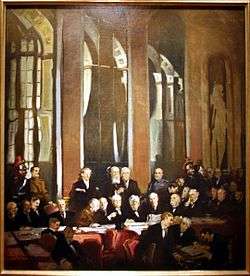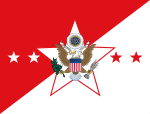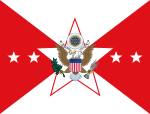Tasker H. Bliss
| Tasker H. Bliss | |
|---|---|
|
General Tasker H. Bliss | |
| Born |
December 31, 1853 Lewisburg, Pennsylvania |
| Died |
November 9, 1930 (aged 76) Washington, D.C. |
| Place of burial | Arlington National Cemetery |
| Allegiance |
|
| Service/branch |
|
| Years of service | 1875–1920 |
| Rank |
|
| Commands held | Chief of Staff, U.S. Army |
| Battles/wars |
Spanish American War Moro Rebellion World War I |
| Awards | Distinguished Service Medal |
Tasker Howard Bliss, GCMG, (December 31, 1853 – November 9, 1930) was Chief of Staff of the United States Army from September 22, 1917 until May 18, 1918.
Biography
Tasker Howard Bliss was born on 31 December 1853 in Lewisburg, Pennsylvania, to George Ripley Bliss and Mary Ann (née Raymond) Bliss. He attended Bucknell (then Lewisburg) University for one year, where he was a member of Phi Kappa Psi Fraternity,[1] before entering the United States Military Academy (USMA) at West Point, New York. At the USMA, he excelled in languages, mathematics, and tactics and graduated eighth in his class on 16 June 1875.
1875-1897
Upon graduation, he was commissioned a second lieutenant in the 1st Artillery and performed routine garrison duties in Georgia and New York. On 14 September 1876, he was appointed to the USMA as an Assistant Professor of French until 1882. While assigned to the USMA, he was promoted to first lieutenant.
Bliss married Eleanor (or Eleanora) E. Anderson on 24 May 1882. In late 1882, he was assigned to Fort Mason, California, and Fort Monroe, Virginia. Their first child, Eleanor F, was born in January 1884. In 1885, he was an instructor at the Naval War College where he was sent to England, Germany, and France to study their military schools. The purpose of the trip was to determine if United States military schools were teaching similar and relevant material. He returned to the United States and on 16 May 1888, he was assigned to be aide-de-camp to U.S. Army Commanding General John M. Schofield. A concurrent assignment while aide-de-camp was Inspector of Artillery and Small Arms. During this time, the Blisses' son Edward Goring was born in June 1892.
On 20 December 1892, while aide-de-camp, he was promoted to Captain, Staff, Commissary of Subsistence and on 26 September 1895 he was assigned to special duty at the office of the Secretary of War. On 4 March 1897, he was assigned as the Quartermaster and Commissary at Fort Monroe, Virginia. On 2 July 1897, he was sent to Spain as the military attaché to the United States Legation. When war was declared between Spain and the United States, Captain Bliss was ordered to return to the U.S., via Paris, on 21 April 1898.
Spanish–American War
On 30 April 1898, Bliss was promoted to Major, Staff, Commissary of Subsistence and on 9 May to Lieutenant Colonel and Chief, Commissary of Subsistence, U.S. Volunteers. Lieutenant Colonel Bliss was then assigned to the 6th Army Corps as Chief Commissary, 23 May 1898, and then Camp George H. Thomas, in Chickamauga, Georgia, until ordered to Santiago, Cuba, and then Puerto Rico on 20 July 1898. Colonel Bliss arrived in Ponce, Puerto Rico, in early August and was appointed as the Chief of Staff, 1st Division, I Army Corps, under Major General James H. Wilson. Concurrent assignments included being a board member to select camp sites in Cuba and chief commissary of the I Army Corps.
Time in Cuba
Bliss was ordered to Havana, Cuba on 15 December 1898, as Collector of Customs for the Island of Cuba and the Port of Havana. On 13 June 1899 LTC Bliss received an honorable discharge from the U.S. Volunteers and returned to the Regular Army. While serving as Chief, Collector of Customs for the Island of Cuba and the Port of Havana he was also the President of the Commission to Revise the Cuban Tariff Treaty in 1901 and was appointed to the Army War College Board as Special Envoy to Cuba to negotiate the treaty ratification in November and December 1902. The Treaty was ratified and signed on 17 December 1903.
In 1900 Bliss was elected as a veteran companion of the Pennsylvania Commandery of the Military Order of Foreign Wars.
General staff (first tour)
Lieutenant Colonel Bliss was commissioned as a brigadier general in the Regular Army by an Act of Congress under direction of the U.S. President Theodore Roosevelt. On 15 August 1903, Brigadier General Bliss was appointed a member of the General Staff, Chief, 3rd Division and President of the Army War College. In September 1904, he participated in the Manassas maneuvers in Virginia.
Philippine Islands
On 7 June 1905, General Bliss was ordered the Philippine Islands to command the Department of Luzon. On 9 January 1906, he was assigned as commander of the Department of Mindanao and appointed governor of the Moro Province. While still governor of the Moro Province, Bliss was ordered to command the Philippine Division on 14 December 1908. He relinquished all Philippine Islands commands on 6 April 1909, and returned to the U.S. after touring China and Manchuria.
General staff (second tour) and pre-World War I

BG Bliss was assigned to the general staff and president of the U.S. Army War College, 19 June 1909. On 12 August 1910, he was assigned to command the Department of California, in San Francisco, California. On 13 August 1911, he was assigned as Commander, Department of the East, Fort Totten, New York, and subsequently assigned to Commander, Department of the South, Fort Sam Houston, San Antonio, Texas on 26 February 1913.
World War I and Paris Peace Conference
On 13 February 1915, BG Bliss was detailed to the general staff as Assistant Chief of Staff, Army until his promotion to Chief of Staff on 22 September 1917. He was promoted to Major General (MG) in the Regular Army on 20 November 1915 and received a temporary promotion to full General (four star) in the National Army on 6 October 1917. On 17 November 1917, he was assigned as the American Permanent Military Representative, Supreme War Council, concurrent with the U.S. Army Chief of Staff position.

General Bliss was forced to retire due to age limitations, 31 December 1917, but by order of U.S. President Woodrow Wilson, was recalled to active duty on 1 January 1918 and sent to Versailles, France, 23 January, to better carry out his duties on the Supreme War Council. He was relieved as U.S. Army Chief of Staff, 19 May 1918, and returned to his permanent rank of Major General (retired) 20 May 1918.[2] After the signing of the armistice ending World War I, on 11 November 1918, General Bliss held two titles, the American Permanent Military Representative, Supreme War Council, and also, Plenipotentiary at the Paris Peace Conference. This assignment was concluded on 10 December 1919.
After World War I
On 1 May 1920, Bliss was assigned as governor of the U.S. Soldiers Home, Washington, DC. He retired from that position on 1 May 1927. He was reinstated as a full general, retired, on 21 June 1930, and died on 9 November 1930. He is buried in Arlington National Cemetery, Washington, DC.
Family
Edward Goring Bliss was the son of Tasker and Eleanor E. Bliss. Born on 2 June 1892, he graduated from the USMA in 1916 and was commissioned a 2nd Lieutenant in the Engineer Corps. He saw service in Siberia in 1918-1919 and through World War II. He retired with the rank of lieutenant colonel.
His daughter Eleanora, born in 1885, attended Bryn Mawr College where she became the first women to gain a doctorate in geology. She joined the United States Geological Survey where she met and married fellow geologist, Adolph Knopf.[3][4]
Dates of rank
| Insignia | Rank | Date | Component |
|---|---|---|---|
| None in 1875 | Second lieutenant | 16 June 1875 | Regular Army |
| First lieutenant | 1 July 1880 | Regular Army | |
| Captain | 20 December 1892 | Regular Army | |
| Major | 30 April 1898 | Regular Army | |
| Lieutenant colonel | 9 May 1898 | Volunteers | |
| Brigadier general | 26 April 1901 | Volunteers | |
| Brigadier general | 21 July 1902 | Regular Army | |
| Major general | 20 November 1915 | Regular Army | |
| General | 6 October 1917 | National Army | |
| Major general | 19 May 1918 | Retired list | |
| General | 21 June 1930 | Retired list |
Bliss was never commissioned as a colonel. He was promoted to brigadier general from lieutenant colonel by an act of Congress at the President's request.
Bliss was also never commissioned as a lieutenant general. He was appointed a general by the U.S. President under U.S. Code, Title 10, Subtitle A, Part I, Chapter 6, § 164.
Awards and decorations
| Army Distinguished Service Medal | |
| Spanish Campaign Medal | |
| Philippine Campaign Medal | |
| Army of Cuban Occupation Medal | |
| Mexican Border Service Medal | |
| World War I Victory Medal | |
| Knight Grand Cross of the Order of St Michael and St George (UK) | |
| Grand Croix Légion d'Honneur (France) | |
| Grand Cross Order of the Crown (Belgium) | |
| Grand Cross Order of Saints Maurice and Lazarus (Italy) | |
| War Merit Cross (Italy) | |
| Grand Cordon Order of the Rising Sun (Japan) | |
| Polonia Restituta (Poland) | |
| Medal of Solidarity, 1918 (Panama) |
Legacy
The U.S. Navy transports USS Tasker H. Bliss (AP-42) and USS General T. H. Bliss (AP-131) were named after him.
A portrait of General Bliss hangs in Luce Hall at the United States Naval War College.
Contrary to popular belief, Fort Bliss, Texas is not named after him. Fort Bliss is named for Lieutenant Colonel William Wallace Smith Bliss, a veteran of the Mexican War.
References
- ↑ Phi Kappa Psi (1991). Grand Catalogue of the Phi Kappa Psi Fraternity (13th ed.). Publishing Concepts, Inc. 1991. pp. 35, 553.
- ↑ Army Register, 1922. pg. 1212.
- ↑ Army Heritage and Education Center, Tasker H. Bliss Collection Finding Aid (Online catalog) http://www.ahco.army.mil/site/index.jsp
- ↑ Aldrich, Michele L. (1980), "Knopf, Eleanora Frances Bliss", Notable American Women: The Modern Period, Harvard University Press, pp. 401–403, ISBN 9780674627338
- Tasker H. Bliss Collection US Army Heritage and Education Center, Carlisle, Pennsylvania
External links
| Wikimedia Commons has media related to Tasker H. Bliss. |
- Men of Mark in America Biography & Portrait
- "Tasker H. Bliss". Find a Grave. Retrieved 2009-05-18.
| Military offices | ||
|---|---|---|
| Preceded by Hugh L. Scott |
Chief of Staff of the United States Army 1917–1918 |
Succeeded by Peyton C. March |

